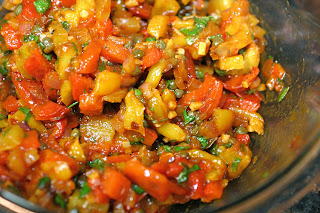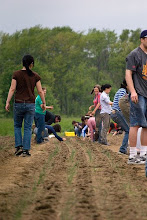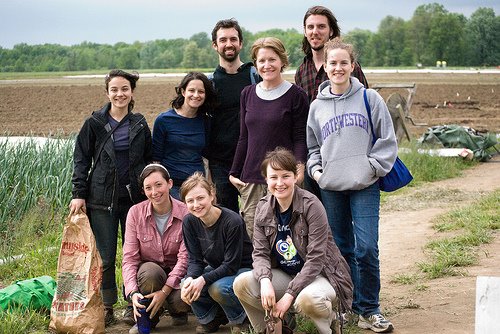
Pretty Beets from todays CSA waiting to be pickled.....

Delicious served on crackers or crostini, meaning little toasts, if you feel like doing a little extra work.
· 2 yellow bell peppers
· 2 red bell peppers
· 1/4 cup olive oil
· 2 garlic cloves
· 2 Tbsp. salt packed capers*
· 1 Tbsp. tomato paste
· 1/2 onion, diced
· 1/2 tsp. dried red chile flakes
· 1/2 tsp salt
· 2 Tbsp. red wine vinegar
· chopped parsley, about 1/4 cup
Put the oven on broil. Cut tops off peppers, cut peppers in half and remove seeds. Lay a piece of foil on a baking sheet and lay peppers (including the tops) on sheet, skin side up. Broil until skin blackens. Place peppers in paper bag and let steam. Remove and let cool. Skins should slip off. Chop peppers into small pieces.
Heat the olive oil in a large skillet. Rinse the salt off the capers and dry capers. Add the capers to the oil and fry for about one minute over medium heat. Stir in the tomato paste and cook for a couple of minutes and then add onion, chile flakes and salt and cook, stirring, for about 5 minutes.
Add the vinegar to the pan and deglaze, scraping up any brown bits from the bottom of the pan and then stir in the chopped peppers. Adjust seasoning for more salt or vinegar. Add parsley. Remove topping to a bowl and let cool. Do not refrigerate. Let sit at room temperature until ready to use.
Adapted from Bon Appetit, June 2001
This torte can easily be made ahead and reheated as you need it for guests, or even a meal for a few, if you halve it. In fact, I suspect that it might be even better reheated because there is something about potatoes that have been cooked twice–they’re always better.
And if you’re not reheating it, be patient enough to get a better browning on the bottom than my impatient hunger allowed me to.
This also might work well in a cast iron, though you would probably have to adjust your cooking times slightly.
Makes 8 servings
1 bunch green onions, thinly sliced
1 cup grated Parmesan cheese
2 tablespoons all purpose flour
1 tablespoon chopped fresh thyme
1 1/2 teaspoons salt
3/4 teaspoon ground black pepper
2 pounds Yukon Gold potatoes, peeled, cut into 1/8-inch-thick rounds
12 ounces yellow crookneck squash or regular yellow summer squash, cut into 1/8-inch-thick rounds
6 teaspoons olive oil
Preheat oven to 375°F. Butter two 8-inch-diameter cake pans. (Deb note: I had only a 9-inch pan around, so what you see in my pictures is slightly thinner.) Set aside 1/4 cup sliced green onions. Toss remaining green onions, cheese, flour, thyme, salt and pepper in medium bowl to blend.
Layer 1/6 of potatoes in concentric circles in bottom of 1 prepared pan, overlapping slightly. Layer 1/4 of squash in concentric circles atop potatoes. Drizzle with 1 teaspoon oil. Sprinkle with 1/6 of cheese mixture. Repeat with 1/6 of potatoes, then 1/4 of squash and 1 teaspoon oil. Sprinkle with 1/6 of cheese mixture. Top with 1/6 of potatoes. Drizzle with 1 teaspoon oil. Sprinkle with 1/6 of cheese mixture and press gently to flatten. Repeat procedure with second cake pan and remaining potatoes, squash, oil, and cheese mixture.
Cover pans with foil. Bake until potatoes are almost tender, about 40 minutes. Remove foil; bake uncovered until tortes begin to brown and potatoes are tender, about 25 minutes longer. (Can be made 6 hours ahead. Cool. Cover with foil and chill. Rewarm, covered with foil, in 350°F oven until heated through, about 30 minutes.)
Cut each torte into wedges. Sprinkle wedges with 1/4 cup green onions; serve.
· Salad Greens
· Tuscan Kale
· Beets
· Herbs
· Eggplant
· Garlic
· Sweet corn


· 1 small red cabbage
· 25g butter
· 1 large onion, finely sliced
· ½ tsp ground allspice
· ¼ tsp freshly grated nutmeg
· 1 Apple, peeled, cored and grated
· 4 tbsp red wine vinegar
· 2 tbsp light muscovado sugar
· 2 tbsp redcurrant jelly
Finely slice the cabbage, discarding the core and any tough pieces. Melt the butter in a pan with a tight-fitting lid over a medium heat. Cook the onion uncovered for 5 minutes until soft but not browned.
Stir in the spices then add the cabbage, apple, red wine vinegar and sugar plus 100ml cold water. Stir until thoroughly mixed and the sugar has dissolved. Season generously. Bring to the boil, then cover tightly and simmer for about 1 hour, stirring occasionally, until the cabbage is very tender and the liquid has evaporated. Stir in the redcurrant jelly, allow to melt, then serve. | ||||||||||
The red cabbage (Brassica oleracea var. capitata f. rubra) is a sort of cabbage, also known as Red Kraut or Blue Kraut after preparation. Its leaves are coloured dark red/purple. However, the plant changes its colour according to the pH value of the soil, due to a pigment called anthocyanin.
On acidic soils, the leaves grow more reddish while an alkaline soil will produce rather greenish-yellow coloured cabbages. This explains the fact that the very same plant is known by different colours in various regions. Furthermore, the juice of red cabbage can be used as a home-made pH indicator, turning red in acid and blue in basic solutions. It can be found in Northern Europe, throughout the Americas, and in China.
On cooking, red cabbage will normally turn blue. To retain the red colour it is necessary to add vinegar or acidic fruit to the pot.
Red cabbage needs well fertilized soil and sufficient humidity to grow. It is a seasonal plant which is seeded in spring and harvested in late fall. Red cabbage is a better keeper than its "white" relatives and does not need to be converted to sauerkraut to last the winter.

Peel cucumber. Cut lengthwise into 1/4-inch strips, then into thin slices crosswise. Blot off moisture with paper towels. Toast cumin seeds for a few seconds in a small, heavy frying pan over high heat. In a bowl, stir yogurt until it is smooth. Mix it with the cumin, garlic and coriander or mint leaves. Combine mixture with cucumber slivers, sprinkle with cayenne or paprika, and chill before serving. | |||||||||||||||||||||||||||||||||
| | |||||||||||||||||||||||||||||||||

Dear Pistil Farm Member
Thank you for supporting my farm in its first season! I am so happy to be growing colourful energetic flowers to brighten your urban habitat.
These flowers are grown organically in Tivoli, New York (right next to Hearty Roots). To find out more about the varieties you’ll be receiving go to Pistil Farm. At the website you can also order extra bouquets for special gifts and people. Any questions just email pistilfarm@gmail.com.
Thanks Again!! Lindsey

This Saturday marks the second delivery of Awesome Farm chickens to Brooklyn. The chickens will be available for pick up between 11-1 at the Red Shed Garden.
There will be a few extra chickens available if you or someone you know is interested in purchasing a bird on the spot. Please bring a cash or check, and a bag or cooler to carry them home in.
Heres some Roast Chicken Ideas:-
Roast Chicken with Chili & Basil from Ottolenghi
Nigel Slaters Best Roast Chicken ever!
Forgive the UK slant this week!!

Non Stick pan, 6 baby squash & zucchini, 1/2 tbsp oil, 5 eggs, lemon thyme, salt & pepper,
Gently sauté the squash and zucchini with the oil, until soft. Beat the eggs together, add lemon thyme, salt and pepper. Evenly distribute the squash in the pan and add the egg mixture. Cook on a medium flame until egg is set and starting to brown, slip under broiler to brown top. Once done slide onto a plate and let cool.

Cover beets with water by 1 inch in a 2- to 3-quart saucepan and simmer until tender when pierced in center with a fork, about 30 minutes. Drain in a colander and rinse under cold running water. Let stand until cool enough to handle, then slip off and discard skins. Cut beets into 1/4-inch-thick slices.
While beets are cooking, stir together scallions, 2 tablespoons vinegar, lemon juice to taste, mint, zest, salt, and pepper in a bowl. Add oil in a slow stream, whisking until combined. Add warm beets and toss with vinaigrette and vinegar and salt to taste. Serve warm or slightly chilled.
*Sometimes called candy-cane beets, chioggias become more aggressive in flavor as they age, so search out relatively young beets, with a diameter of 1 1/2 to 2 inches.

Of course we hope that you enjoy your first fruit share from Montgomery Place Orchards. If you would like to see some pictures of our farm, please visit montgomeryplaceorchards.
Your fruit this week includes black raspberries, blueberries, and sour cherries.
Sour cherries are also referred to as tart, red cherries, or pie cherries and are usually not eaten fresh but used in recipes. Because they are so perishable and the season is so short, you never see these sold fresh in a super market. Please refrigerate the cherries immediately and use within 2 days. You can freeze them by spreading them out on a cookie sheet and freezing for a few hours and then place them in freezer quality plastic bags.
Sour Cherry Sauce (makes about 2 ½ cups)
3 T brown sugar
1 T cider vinegar
3 t corn starch
1 t vanilla extract
½ t. ground cinnamon
1 pint fresh red sour cherries pitted
1 cup apple juice
Combine brown sugar, cornstarch, and cinnamon in a medium saucepan. Mix in apple juice, cider vinegar and vanilla extract. Cook over medium heat until thickened. Cook for another 2 minutes. Stir in red sour cherries and heat thoroughly. Serve warm with ham or pork or spoon over dishes of ice cream for dessert.
The term ‘true blue’ has to come from blueberries. They are such a wonderful, dependable fruit. They are a little picky about what soil they grow in but that is about it. They bloom late enough that we don’t have to worry about spring frosts, too much rain doesn’t seem to bother them and too much sun just makes them sweeter. The season is just about the entire month of July, so plan on eating some more of these next week.
This week our farm has been ‘in the black’. We always feel like we have been hit by a black raspberry tsunami the first week of July. But, we love it. EVERYONE”S hands are black from working with black raspberries. They are being harvested every day and then turned into jam or vinegar. Everyone’s teeth are black from eating soo many. This season is short though, usually only 10 days so like us, enjoy them while you can.
We have learned as farmers that we can do everything right but in the end fruit is just a gift from Mother Nature. We hope you enjoy our harvest as much as we do.
Doug and Talea Fincke and everyone at Montgomery Place Orchards
And in our line of work, loops are not always that great.
The week of June 7th saw sudden thunder storms, fields under the siege of rain clouds and mud filled trenches. When the week ended, we had 3.09 inches of rainwater to deal with. The turtles in the pond loved it, but my irrigation lines were stuck without a paycheck. The next week we got hit again by these lightning rich thunder and rain clouds, as huge systems of weather spun in from who knows where. (I tried to look it up, but just kept getting routed to a netflix page). That week we got 3.60 inches. Incredible. I knew my rain gear was going to come in handy, but I didn't realize it was to become my permanent uniform.
Irrigation work was not the only thing that suffered because of these storms. Our infantry saw legions of weeds growing everywhere on the farm, given strength by the water and taking the opportunity to thrive during our inability to cultivate effectively. We spent days on the ground, pulling crab grass clusters out of the garlic, and lamb's quarters out of the root vegetables. Two more weeks of torrential wet weather followed. As of today we have had 11 inches of rain since the 7th.
Things are still growing, and we are still harvesting, but everyone wants to know when this weather will end. An impossible to answer question. Unless you can see into the future. Which I can't do. Yet. Just going to go back to my irrigation lines, set up the infrastructure for when the dry season does arrive, and hope that the drip tape doesn't lose its edge.


INGREDIENTS
If pepper and cumin already ground, mix them together. Otherwise, grind the two spices together.
Put beets and garlic in a blender or VitaMix.
Add as muchcoconut milk as it takes to cover the beets, then blend them together.
Add spice mixture and blend some more.
FOR SOUP: Add water. Serve with swirls of coconut milk and sprigs of cilantro or mint or parsley.
From Haramara retreat - http://www.haramararetreat.com
Preheat broiler.
Whisk together vinegar, garlic, lemon juice, 1/2 cup oil, and 1/2 teaspoon each of salt and pepper in a large bowl.
Put radicchio in a 4-sided sheet pan and toss with remaining 2 tablespoons oil. Broil 5 to 6 inches from heat, turning occasionally, until slightly wilted, 3 to 4 minutes.
Add hot radicchio to balsamic marinade and gently toss to coat. Cover bowl (to keep heat in) and marinate, tossing once or twice, at least 1 hour.
Transfer radicchio to a serving dish, pouring some of marinade over top. Scatter basil over radicchio. Drizzle ricotta with oil in a small bowl and serve with radicchio.


